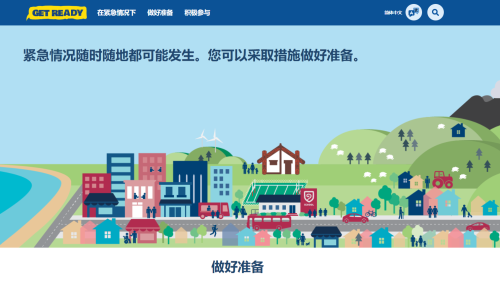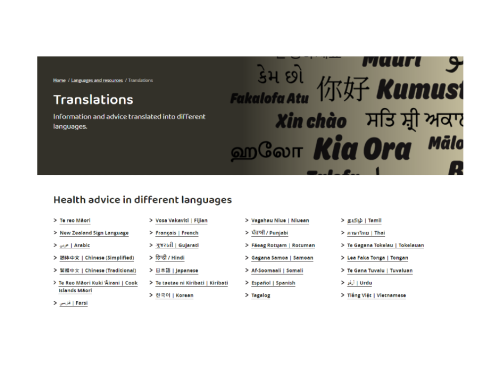On this page
New Temporary Visa for Ukrainian Migrants
Immigration New Zealand, the Ministry of Business, Innovation and Employment | Hīkina Whakatutuki

About the project
In 2022, the Special Ukraine Visa was put in place, which allows Ukrainian New Zealanders to apply to bring family members that are still in Ukraine to New Zealand. MBIE published information about the visa on their website in English, and provided translations as well.
Which languages?
- Russian
- Ukrainian
Why these languages?
The decision was taken to translate the website content into these two languages to reach as many people as possible, so they could get information on the new visa.
While they were obvious languages, translating the information, rather than just providing information in English, gave the content more potential to be wide-reaching and accessible to those in need of the information.
How successful have the translations been?
The pages had around 4,000 unique views between April 2022 and November 2022. As of 1 November 2022, were roughly 1,000 visa applications approved and just over 400 applicants had arrived in Aotearoa New Zealand under this visa category.
Anecdotal feedback suggests that the translations were useful for those applicants whose first language was not English, particularly in understanding the specific requirements of the visa. In what was a stressful time for many Ukrainians, being able to access information in their language provided some comfort, relative to having to access this in a language with which they were not familiar.
Go to the New Temporary Visa for Ukrainian Migrants webpage
Vaccine rollout collateral
COVID-19 Group, Department of the Prime Minister and Cabinet | Te Tari o te Pirimia me te Komiti Matua


About the project
Amid the COVID-19 vaccine rollout, Ministry of Health | Manatū Hauora data showed that African community vaccination rates were lower than those of other ethnic communities in Aotearoa New Zealand. The aim was to increase these rates, so they were aligned with the vaccination rates for other communities.
Which languages?
- Amharic
- Arabic
- French
- Rohingya
- Somali
- Shona
- Swahili
- Tigrinya
- West African Pijin
Why these languages?
The COVID-19 Group worked with African community leaders to develop resources and information in formats and languages that would resonate best with African communities.
This not only involved translating information in 9 languages, but also creating collateral with designs that resonated with African cultures. The COVID-19 Group worked with a designer and the African community leaders to produce designs relevant to North, East, South and West Africans in Aotearoa New Zealand.
This idea was then extended to Chinese, Indian, and Pacific communities, where cultural designs were subsequently integrated into collateral.
How successful have the translations been?
It is difficult to measure the direct impact of this initiative given there were many factors at play, but over time the African vaccination rate did increase to align with the numbers seen across the rest of Aotearoa New Zealand’s ethnic community populations.
African leaders commented that the resources received good feedback. The cultural designs were also subsequently used for other health-related purposes.
Get Ready
National Emergency Management Agency | Te Rākau Whakamarumaru

About the project
Get Ready supports individuals, whānau, communities, schools, and businesses to get ready for, respond to and recover from emergency events. The National Emergency Management Agency (NEMA) want to ensure that emergency preparedness information is available to everyone. But until 2021, most of their content was only available in English. There was only a handful of information in other languages, and it wasn’t as digitally accessible as it could have been.
The Get Ready Accessibility and Multilingual project has lifted the website to the New Zealand Government Web Accessibility Standards and the Web Content Accessibility Guidelines (WCAG) 2.1 to Level AA. WCAG is an international shared standard for web accessibility. The project has also provided almost all their information in multiple languages and in audio, large print and Easy Read.
Which languages?
- te reo Māori
- New Zealand Sign Language
- Arabic
- Cook Islands Māori
- Chinese (Simplified)
- Chinese (Traditional)
- Hindi
- Japanese
- Niuean
- Punjabi
- Samoan
- Spanish
- Tagalog
- Tongan
Why these languages?
Te reo Māori and New Zealand Sign Language as official languages of Aotearoa New Zealand were automatically chosen for translation. NEMA chose their other languages based on several factors, including:
- Population – How many speakers of the language are in Aotearoa New Zealand and how many are less likely to speak English as well (data provided by StatsNZ).
- English proficiency – The likely English proficiency of the population based on data from Stats NZ, government interpreting services, and the English Proficiency Index.
- Access to interpreters – Languages with limited or no interpreting availability were given higher priority.
- Realm countries
- Preparedness – Their own annual research has shown that Asian New Zealanders are less likely to be prepared for an emergency, which affected the priority they gave to languages that might be spoken by these groups.
These factors were weighted to develop a list of priority languages to translate.
How successful have the translations been?
The feedback received so far from emergency managers has been very positive. To NEMA, success is more people getting ready for emergencies. And that means people need to be able to access the information they need in the language or format they choose.
During Cyclone Gabrielle, there were over 15,000 page views for the top non-English languages, which were Simplified Chinese, Traditional Chinese, Arabic, Tagalog, Spanish and New Zealand Sign Language.
Unite Against COVID-19
COVID-19 Group, Department of the Prime Minister and Cabinet | Te Tari o te Pirimia me te Komiti Matua
About the project
Information about Aotearoa New Zealand’s response to COVID-19 was translated across a number of languages and formats to ensure all communities had equitable access to important information regarding the response to the pandemic. For accessibility purposes, the information was presented mostly as HTML content with a smaller range of pdf resources for downloading and printing, and videos with subtitles.
Which languages?
- te reo Māori
- New Zealand Sign Language
- Arabic
- Chinese (Simplified)
- Chinese (Traditional)
- Cook Islands Māori
- Farsi
- Fijian
- French
- Gujarati
- Hindi
- Japanese
- Kiribati
- Korean
- Niuean
- Punjabi
- Rotuman
- Samoan
- Somali
- Spanish
- Tagalog
- Tamil
- Thai
- Tokelauan
- Tongan
- Tuvaluan
- Urdu
- Vietnamese
Information was also translated into Easy Read, Large Print, Audio and Braille for Aotearoa New Zealand’s disabled communities.
Why these languages?
The COVID-19 Group prioritised translations into te reo Māori and New Zealand Sign language as these are official languages of Aotearoa New Zealand, as well as the 9 Pacific Languages on the recommendation of the Ministry for Pacific Peoples.
The other 17 languages that were translated were chosen based on several factors, including:
- 2013 and 2018 Census data
- The highest frequency languages for which government receives interpreting requests
- Advice and data provided by other central government organizations, local government organizations, and District Health Boards with connections into ethnic and Pacific communities.
For the rest of Aotearoa New Zealand’s communities for whom there are other language barriers, there was a reliance on community leaders and organisations to ensure key messages related to COVID-19 reached them.
An assumption was made that the English literacy rates of speakers of some languages in Aotearoa New Zealand would be good enough to understand the English messaging and therefore the need for translation into these languages is low. This applied to some communities that are quite large, for example, German, Afrikaans, Dutch, Russian and Italian.
How successful have the translations been?
Given the wide-reaching impacts of COVID-19, it is no surprise that the viewership of translated content on the Unite against COVID-19 website has been high. In the period between March 2020 and June 2023, there were a total of just over 2 million unique page views across the 27 languages.
The top 5 viewed languages (and the number of unique page views) on the website were:
- Tagalog - 661,892 (noting most webpage views came from The Philippines)
- Simplified Chinese - 354,747
- Hindi - 128,689
- Japanese - 116,312
- Traditional Chinese - 84,039
